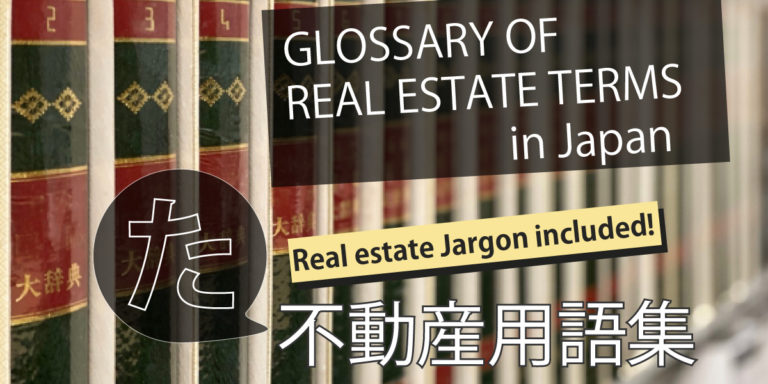- 1 Real estate Terms -た(TA),だ(DA)-
- 1.0.1 耐火建築物 [TAIKA KENCHIKU BUTSU] (たいかけんちくぶつ)
- 1.0.2 耐火構造 [TAIKA KOUZOU] (たいかこうぞう)
- 1.0.3 大規模修繕 [DAIKIBO SYUZEN] (だいきぼしゅうぜん)
- 1.0.4 貸借対照表 [TAISHAKU TAISHOUHYOU](たいしゃくたいしょうひょう)
- 1.0.5 耐震基準 [TAISHIN KIJUN] (たいしんきじゅん)
- 1.0.6 代表者印 [DAIHYOUSHA IN] (だいひょうしゃいん)
- 1.0.7 太陽光発電 [TAIYOUKOU HATSUDEN] (たいようこうはつでん)
- 1.0.8 耐用年数 [TAIYOU NENSUU] (たいようねんすう)
- 1.0.9 タイルカーペット[TILE CARPET] (たいるかーぺっと)
- 1.0.10 タウンハウス [TOWN HOUSE] (たうんはうす)
- 1.0.11 ダウンライト [DOWN LIGHT] (だうんらいと)
- 1.0.12 宅地造成 [TAKUCHI ZOUSEI] (たくちぞうせい)
- 1.0.13 宅地建物取引業 [TAKUCHI TATEMONO TORIHIKIGYOU] (たくちたてものとりひきぎょう)
- 1.0.14 宅地建物取引業者 [TAKUCHI TATEMONO TORIHIKI GOUSHA] (たくちたてものとりひきぎょうしゃ)
- 1.0.15 宅地建物取引士 [TAKUCHI TATEMONO TORIHIKISHI] (たくちたてものとりひきし)
- 1.0.16 立退料 [TACHINOKI RYOU] (たちのきりょう)
- 1.0.17 建売住宅 [TATEURI JYUTAKU] (たてうりじゅうたく)
- 1.0.18 建具 [TATEGU] (たてぐ)
- 1.0.19 断熱材 [DANNETSU ZAI] (だんねつざい)
- 1.0.20 担保責任 [TANPO SEKININ] (たんぽせきにん)
Real estate Terms -た(TA),だ(DA)-
耐火建築物 [TAIKA KENCHIKU BUTSU] (たいかけんちくぶつ)
In the Building Standards, “fireproof building” means a building whose main structure (walls, pillars, floors, beams, roofs, and stairs) meets fire resistance standards and has fireproofing equipment such as fire doors in the openings (windows and doors) to prevent fire from spreading.
耐火構造 [TAIKA KOUZOU] (たいかこうぞう)
In the Building Regulations, a building structure in which the structure of walls, columns, floors and other parts of the building conforms to fire resistance.
Fire resistance is defined as the performance required for the part of the building to prevent the building from collapsing and spreading until the end of an ordinary fire.
大規模修繕 [DAIKIBO SYUZEN] (だいきぼしゅうぜん)
Planned repairs to maintain the performance of condominiums and prevent them from becoming obsolete, which require a large amount of money.
Specifically, it refers to various kinds of repair works such as iron painting, exterior wall painting, rooftop waterproofing, water supply pipe work, and drainage pipe work.
貸借対照表 [TAISHAKU TAISHOUHYOU](たいしゃくたいしょうひょう)
Balance Sheet. A document that reveals the financial status of an entity at a certain point in time.
耐震基準 [TAISHIN KIJUN] (たいしんきじゅん)
Technical structural standards that buildings must have in place to be safe in the event of an earthquake
代表者印 [DAIHYOUSHA IN] (だいひょうしゃいん)
A seal of the representative director of a company that has been registered to the registry office.
It is also called 丸印 [MARU IN] (まるいん) because it is common to have a circular seal.
太陽光発電 [TAIYOUKOU HATSUDEN] (たいようこうはつでん)
A method of power generation that uses solar cells to convert the energy of sunlight directly into electricity
耐用年数 [TAIYOU NENSUU] (たいようねんすう)
The number of years a building, machine or appliance can withstand use. It depends on the state of control as well as the materials and construction.
In financial accounting, the useful life is defined as a standard for calculating depreciation expense. For example, the statutory useful life of residential buildings is 22 years for wood-frame buildings, 47 years for reinforced concrete and steel reinforced concrete buildings, 27 years for lightweight steel-frame buildings (more than 3 mm and less than 4 mm thickness of skeletal material), and so on.
タイルカーペット[TILE CARPET] (たいるかーぺっと)
Small carpets processed into a square shape (e.g. 50cm x 50cm). It is mainly used in offices because it is easy to replace dirty parts and can be easily removed temporarily for wiring work under the floor.
タウンハウス [TOWN HOUSE] (たうんはうす)
A townhouse is a type of housing complex like a condominium or apartment. It is a housing complex of several houses with walls connected to the neighboring houses.
Most of them are low-rise houses with two or three stories.
According to building regulations, マンション [MANSION] are considered 共同住宅 [kyodou jyutaku] (きょうどうじゅうたく)”communal housing” and タウンハウス [TOWN HOUSE] are considered 長屋 [NAGAYA] (ながや). The difference between the two is the presence or absence of common areas. Both types of houses share a single building, but TOWN HOUSE is characterized by independent entrances that can be accessed directly from the outside of each unit.
テラスハウス [TERRACE HOUSE] (てらすはうす) is also connected to the walls of neighboring houses, so they look very similar from the outside, but the rights to the land are very different.
In a terrace house, each piece of land is owned individually, but in a townhouse, the land is shared as a site right according to the ratio of the exclusive area of the building.
ダウンライト [DOWN LIGHT] (だうんらいと)
A light fixture embedded in the ceiling that illuminates the underside of the ceiling.
宅地造成 [TAKUCHI ZOUSEI] (たくちぞうせい)
In general, construction work such as cutting and filling to eliminate slopes, installation of retaining walls, installation of drainage facilities, and ground improvement to make the land functional as a housing site.
宅地建物取引業 [TAKUCHI TATEMONO TORIHIKIGYOU] (たくちたてものとりひきぎょう)
Engaging in land and building transactions as a business.
That transaction is to buy, sell or exchange land and buildings, or to act as an intermediary or agent for the sale, exchange or lease of land and buildings.
宅地建物取引業者 [TAKUCHI TATEMONO TORIHIKI GOUSHA] (たくちたてものとりひきぎょうしゃ)
An individual or corporation that obtains a real estate transaction license and engages in the real estate transaction business.
宅地建物取引士 [TAKUCHI TATEMONO TORIHIKISHI] (たくちたてものとりひきし)
A person who has passed the examination for the knowledge required for the real estate transaction business and is registered with the prefectural government.
立退料 [TACHINOKI RYOU] (たちのきりょう)
Money paid by the lessor to the lessee at the time of surrender of a land or house lease.
建売住宅 [TATEURI JYUTAKU] (たてうりじゅうたく)
A single-house built on a subdivision housing and sold together with the site. A purchaser buys a house with the site.
建具 [TATEGU] (たてぐ)
Fixtures. A retractable facility installed as a room divider. 引き戸[HIKIDO](ひきど)Sliding doors, 障子[SHOUJI](しょうじ), and 襖 [FUSUMA] (ふすま) are all fixtures.
断熱材 [DANNETSU ZAI] (だんねつざい)
Materials used to prevent heat transfer
担保責任 [TANPO SEKININ] (たんぽせきにん)
When selling art, used cars or real estate, the seller’s liability if the item for sale is incompatible with the contract.

